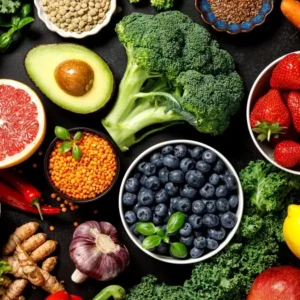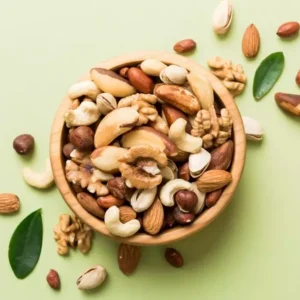Verified on 12/18/2023 by PasseportSanté
Cholesterol is a lipid belonging to the sterol family. Although it has had a bad press in recent years, cholesterol is an essential nutrient for the proper functioning of the body. It is mainly synthesized in the liver but can also be provided through food.
Within the human body, cholesterol can be transported by different specific proteins including HDL cholesterol and LDL cholesterol. Including the levels of these two transporters within the body, the total cholesterol level, or cholesterol level, is a value commonly measured to prevent or identify hypercholesterolemia.
Characteristics of cholesterol:
- lipid from the sterol family essential to the body;
- HDL and LDL cholesterol designate two cholesterol transporters;
- is found mainly in products of animal origin;
- in excess, it increases the risk of cardiovascular accidents.
Cholesterol: definition, analysis
If cholesterol is an essential nutrient for the proper functioning of the body, the human body has the capacity to synthesize it. More than two thirds of the cholesterol present in the body is synthesized by foie. The rest comes from food sources like meat and eggs. With a few exceptions, it is believed that the body can produce enough cholesterol to cover its daily needs.
Cholesterol levels and analysis
The calculation of total cholesterol takes into account the HDL cholesterol level and the LDL cholesterol level. During a cholesterol analysis, it is considered that normal total cholesterol level in adults should be less than 2 g/L, or 5 mmol/L. However, this reference value can vary depending on different parameters including age, sex and medical history.
Analyzing total cholesterol is a good start but it is not enough; it is also important to know precisely the LDL and HDL levels as well as the total cholesterol/HDL ratio.
What is the HDL total cholesterol ratio?
The total cholesterol/HDL ratio measures cardiovascular risk. It is used less and less. However, we still consider that beyond 4.0 there is a significant arterial risk.
Analysis of cholesterol levels and normal values
The blood test allows you to know precisely the values of the different lipids circulating in the blood. Here are the reference values for the interpretation of blood tests.
| Blood levels | Normal reference values |
| Total cholesterol | <2g/L |
| LDL | <1,6g/L |
| HDL | > 0.35g/L |
| Total cholesterol/HDL | <4 |
| Triglycerides | <1,5g/L |
Foods high in cholesterol
Cholesterol is found in foods of animal origin. Among them, here are 10 of the foods richest in cholesterol:
| Food (per 100 g) | Cholesterol content (in mg) |
| Brain | 3100 |
| Egg yolk | 1140 |
| Duck foie gras | 1040 |
| Lamb kidney | 588 |
| Muzzle | 587 |
| Poultry liver | 530 |
| Cod liver oil | 510 |
| Lamb liver | 410 |
| veal kidney | 396 |
| Butter | 215 |
 Receive every day
Receive every day
advice from our experts
to take care of you

Benefits and roles of cholesterol
Structural role of cholesterol
Cholesterol participates in the structure of cell membranes. It enters the composition of the lipid bilayers of membranes by intercalating between the phospholipids. Cholesterol thus contributes to the stability and strengthening of membranes.
Precursor role for the synthesis of hormones and vitamins
Cholesterol is a precursor of many essential molecules in the body. For example, he participates in the synthesis:
- steroid hormones such asaldosterone and cortisol;
- sex steroid hormones such as estrogen, progesterone and testosterone;
- vitamin D.
Role of cholesterol in digestion
Cholesterol contributes to the synthesis of bile salts present in bile, a fluid necessary for the digestion of lipids.
Cholesterol too high or too low: what are the consequences?
Total cholesterol too high: what are the risks?
Excess cholesterol, or hypercholesterolemia, is a major public health problem. It corresponds to a total cholesterol level greater than 2 g/l. Indeed, high cholesterol increases the risk of cardiovascular diseases.
In excess within the body, cholesterol tends to accumulate in the walls of the arteries, which leads to the formation of atherosclerotic plaque. We then speak of atherosclerosis, the consequences of which for health can be serious. The passage of blood is disrupted, which increases the risk of high blood pressure. The rupture of an atherosclerotic plaque can also lead to a myocardial infarction, stroke (stroke) or obliterating arteriopathy of the lower limbs (PAID).
Total cholesterol level too low: what are the consequences?
Cholesterol deficiency, or hypocholesterolemia, is a rare phenomenon. It may be of genetic origin or may be secondary. This means that it can be the consequence of another phenomenon such as:
- malnutrition;
- cholesterol malabsorption;
- a pathology such as cancer;
- a depressive state.
Cholesterol and its interactions with other nutrients
Recent studies highlight the possible interactions between vitamin E and certain molecules used to treat hypercholesterolemia. Vitamin E is a powerful antioxidant often taken in the form of food supplements to fight against cellular aging.
However, this fat-soluble vitamin would significantly reduce the effectiveness of cholesterol-lowering drugs and partially cancel the protective effect of these treatments on the cardiovascular system. It is therefore recommended that you seek the advice of a doctor before taking vitamin E if you suffer from high cholesterol.
Chemical properties
The crude formula of cholesterol is C27H46O, its molar mass is 386.6535 g/mol. Cholesterol is a lipid belonging to the sterol family and playing a central role in many metabolic reactions.
The cholesterol molecule is bipolar, only the hydrophilic head contains an OH molecule. If this OH molecule is esterified by a fatty acid, the cholesterol molecule then becomes completely insoluble in water. It is in this esterified form, or sterides, that cholesterol circulates in the liver, brain and marrow.
We wrongly speak of “good” or “bad” cholesterol to define HDL cholesterol and LDL cholesterol. However, there is only one cholesterol molecule. HDL and LDL are only transporters of this single molecule. LDL transports cholesterol from the liver to the tissues, promoting deposits in the arteries while HDL transports cholesterol from the tissues to the liver. Hence this amalgamation which has lasted for several decades.
Nutrient History
It was by analyzing gallstones that F. Poulletier discovered the existence of cholesterol for the first time in 1758. However, it was not until the 1950s that the role of cholesterol, and more particularly LDL, was recognized in the occurrence of the cardiovascular illnesses.
It was only after the Second World War that A. Keys will highlight the role of diet in preventing high cholesterol. He is at the origin of the very famous Mediterranean diet.
It was necessary to wait until 1973 for the biochemist A. Endo to discover the first statin. Since then, statins have been used on a very large scale to limit the cardiovascular risks linked to hypercholesterolemia throughout the world.
Our dietitian’s opinion
Cholesterol is a vast subject, the source of many confusions and false beliefs! Of course, diet is a key factor in helping to regulate proven hypercholesterolemia, but let’s not forget that two thirds of cholesterol is endogenous, therefore manufactured by the body itself.
Except in cases of abnormally high cholesterol levels and on the advice of a health professional, it is not necessary to ban foods that are sources of cholesterol from the diet (eggs for example). In fact, a varied, balanced diet based on raw products and predominantly plant-based normally helps regulate blood lipid levels.
Was this article useful to you?












